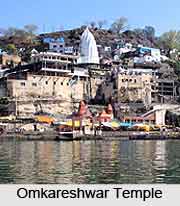 Omkareshwar Temple derives its name from the word Om that is the most pious symbol of Hindus. At the confluence of the rivers Narmada and Kaveri, devotees kneel down before the Jyotirlinga at the temple of Shri Omkar Mandhata.
Omkareshwar Temple derives its name from the word Om that is the most pious symbol of Hindus. At the confluence of the rivers Narmada and Kaveri, devotees kneel down before the Jyotirlinga at the temple of Shri Omkar Mandhata.
The island Mandhata has two hills that are divided by a valley in such a way that it appears in the shape `Om` from above. According to legends two sons of the sun dynasty Mandhata Ambarish and Mucchkund did severe penance in order to please Lord Shiva.
The other legend says that the Vindhya Mountains prayed to Lord Shiva - Omkareshwara and was blessed here. It is also believed that on the request of the Devas, the Shivalinga is split into two, one half being Omkareshwara and the other Amaleshwara. King Mandhatha who belongs to Ishvaku clan is believed to have worshiped Lord Shiva. This temple is built in the North Indian style of architecture with high spires. Here even Panchamuga Ganesha is also worshipped.
This temple is located in the Khandwa district of Madhya Pradesh. It is around 20 km from Mortakka in Madhya Pradesh. Omkareshwar is formed by the Narmada River.
This Jyotirlinga has its own legends. Once Narada visited Vindhya Mountains. He told Vindhya Parvat about the greatness of Mount Meru. This made Vindhya Mountains jealous of Meru and decided to be bigger than Meru. Vindhya Mountain worshipped Lord Shiva. Vindhya Parvat worshipped parthivlinga along with Lord Omkareshwar for six months. Lord Shiva was pleased and granted him his desired boon. Lord Shiva divided the lingas into two parts. One half is called Omkareshwara and the other Mamaleshwar. Lord Shiva granted the benefit of growing, however took a promise that Vindhya will never be a problem to the devotees.
The Vindhya Mountain began to grow thereby not keeping the promise. It also obstructed the sun and the moon. Sage Agastya was approached for help. Agastya and his wife came to Vindhya and convinced that he would not grow until the sage and his wife returned. They never returned.
This article is a stub. You can enrich by adding more information to it. Send your Write Up to content@indianetzone.com





















